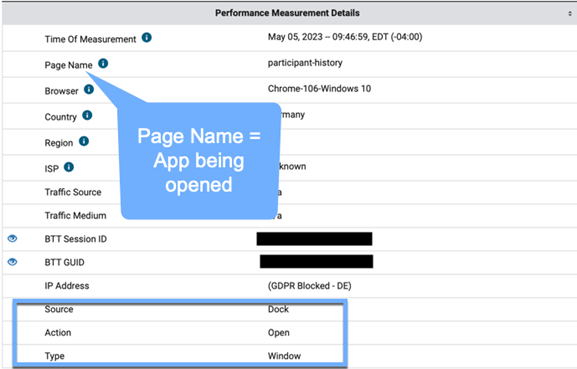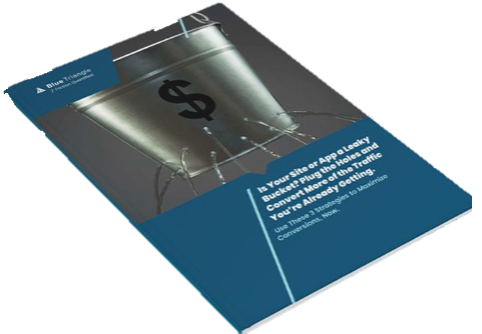Blue Triangle and OpenFin Partner to Help Teams Work Smarter, Faster, and More Effectively - Here's How.
Many growing companies used to live by Meta (formerly Facebook) founder Mark Zuckerberg's now-famous motto: "Move fast and break things."
Meaning if you're too careful, then you're losing business opportunities. It was better to make mistakes and race to put out new products and processes and ask for forgiveness later for any harm to the user experience.
Since then, however, the era of "move fast and break things" is over.
“There’s been a huge transformational shift in how financial institutions compete to build customer trust and loyalty. Leading enterprises see the value of making end-user experiences across third-party and internal apps as frictionless as possible. So, I’m happy to partner with Blue Triangle and help clients deliver elevated experiences and improve business performance,” says Vicky Sanders, Chief Digital Officer, OpenFin.
Move Fast, Break Nothing.
Our strategic partner, OpenFin, the OS for Enterprise Productivity, says it best with their belief in: Move Fast, Break Nothing.
Like Blue Triangle, they help deliver a frictionless user experience that your customers love. From the world's largest financial institutions to emerging startups around the globe, OpenFin is being used by firms of all sizes to build beautiful desktop applications and customer end-user workspaces that drive productivity.
We both believe in creating friction-free digital experiences connected across desktop, tablet, mobile browser, and native mobile app to build trust and loyalty, and ultimately prove bottom-line results and ROI.
So logically, Blue Triangle and OpenFin teaming up was a no-brainer!
"I'm excited to partner with OpenFin to accelerate innovation and time-to-value for our clients. By working together, we're empowering organizations to seamlessly connect the end-user experience from the workspace and internal apps to quantify friction points and identify opportunities to increase productivity and ROI," says Lance Buchholz, Global Head of Sales, Blue Triangle.
Are You Wasting Millions of Dollars?
Many enterprises are failing to maximize their ROI in desktop technology because advanced third-party applications, while highly functional, often don't enable the necessary data sharing and workflow efficiencies required to boost productivity. This means companies spend millions on mission-critical apps that fail to increase effeciences across the enterprise and deliver better user experiences.
So, the developers at OpenFin have introduced an analytics feed in their platform that collects data on how applications are being used. Even with these huge leap forward, customers still have a big opportunity and desire to go even deeper to understand the end-user experience across their entire digital ecosystem.
The ability to visualize and gain actionable insights about the connective tissue between OpenFin and Internal Applications is game-changing for teams to prioritize efforts to optimize user engagement and adoption.
Leveraging Blue Triangle's real user digital experience data can help you analyze the performance of your entire ecosystem and bubble up immediate areas of opportunity to improve end-user engagement.
Watch How Blue Triangle Offers Unparalleled Insights
Every User's Digital Journey is Different
No matter what path they take, we can show you.
One use case that Blue Triangle addresses across the OpenFin instance is the ability to visualize end-user experience across both the workspace and internal applications. Using Blue Triangle's real user data collection, we can create a unified view that will show how users are traversing from OpenFin to an internal application.
This is the 'connective tissue' view that organizations have lacked; providing them with this data will allow them to identify friction points and improve their overall processes quickly.
Here is an example of how this looks:

As you can see here, not only can we show all the different journeys occurring throughout the workspace, but we can also show each step's performance/exit rates.
In addition, if you look at the items outlined in blue, you can see journeys that move away from the workspace into an internal application. This is the unified view we discussed, so you can see everything in one pane of glass.
By understanding the different paths users take to access their internal applications, organizations can identify areas of opportunity to improve end-user experience.
On the technical side of things, once we have completed the configuration, we can dissect the customer journey in even more ways.
Understand How Applications Are (And Are Not) Being Used
Another use case that Blue Triangle addresses is the ability to ingest the analytics feed that OpenFin has introduced in their application. This will allow Blue Triangle to collect application usage and help organizations understand how it's actually being used.
Ultimately, this is achieved by hooking into the already introduced variables and displaying them in the Blue Triangle user interface (UI).
Here is an example of how this looks:

Here you can see the app that was launched as well as exactly how it was accessed. We are aiming to pull in critical attributes such as:
- Source: Identifying the location/origin of the interaction, ex: Home, Dock, etc.
- Action: The exact result of the interaction, ex: Open, Close, New Window
- Type: Identifying the interaction that was made, ex: Window, Page, Navigation
These are just some of the preliminary variables we will be pulling in, and this list can be expanded as needed depending on your organization's needs.
Then, you can utilize the Blue Triangle UI to do different levels of analysis and pull this data via our APIs if needed, which can help in troubleshooting as well.
As you see in the above screenshot, we are assigning a session ID, and we can collect other session IDs if needed. For example, if a user is to open a ticket using the Blue Triangle UI, you can pinpoint their specific session and see all the steps that were taken.
This adapter will now enhance the level of troubleshooting your teams can provide; they can now see the journey to the application level and understand all the interactions a user performs. Your support teams will now be able to replicate a user's journey as closely as possible to help understand whether this was an ongoing or one-off issue.
3 Ways Teams Can Drive Bottom-Line Value
In a recent survey, 85% of IT and LOB leaders agreed that an improved employee experience (EX) leads to a better customer experience (CX) and higher revenue for their organization. We've identified 3 business benefits of connecting the performance of web-based applications to EX and EX:
- Proactively detect and resolve costly points of friction before end-users are impacted.
- Save time and resources by finding the root cause of friction with surgical precision.
- Communicate the business impact of friction across functional teams and leadership with data-driven insights they care about.
See Blue Triangle and OpenFin in Action
Request a Demo to learn more how OpenFin's analytics feed collects application usage data, while Blue Triangle provides real user data to analyze digital experiences across your workspace and internal applications.
.png)
During the holiday rush, every shopper matters
Optimize the customer journey before the eCommerce event of the year.

.jpg)

